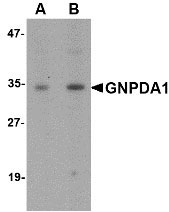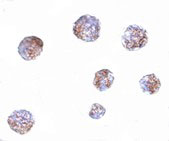GNPDA1 Antibody
- 产品详情
- 实验流程
- 背景知识
Application
| WB, IF, ICC, E |
|---|---|
| Primary Accession | P46926 |
| Other Accession | AAC05123, 2935438 |
| Reactivity | Human, Mouse, Rat |
| Host | Rabbit |
| Clonality | Polyclonal |
| Isotype | IgG |
| Calculated MW | 32669 Da |
| Concentration (mg/ml) | 1 mg/mL |
| Conjugate | Unconjugated |
| Application Notes | GNPDA1 antibody can be used for detection of GNPDA1 by Western blot at 1 - 2 µg/mL. Antibody can also be used for immunocytochemistry starting at 5 µg/mL. For immunofluorescence start at 20 µg/mL. |
| Gene ID | 10007 |
|---|---|
| Other Names | Glucosamine-6-phosphate isomerase 1, 3.5.99.6, Glucosamine-6-phosphate deaminase 1, GNPDA 1, GlcN6P deaminase 1, Oscillin, GNPDA1, GNPI, HLN, KIAA0060 |
| Target/Specificity | GNPDA1; GNPDA1 is predicted to not cross-react with GNPDA2. |
| Reconstitution & Storage | GNPDA1 antibody can be stored at 4℃ for three months and -20℃, stable for up to one year. As with all antibodies care should be taken to avoid repeated freeze thaw cycles. Antibodies should not be exposed to prolonged high temperatures. |
| Precautions | GNPDA1 Antibody is for research use only and not for use in diagnostic or therapeutic procedures. |
| Name | GNPDA1 {ECO:0000303|PubMed:26887390, ECO:0000312|HGNC:HGNC:4417} |
|---|---|
| Function | Catalyzes the reversible conversion of alpha-D-glucosamine 6- phosphate (GlcN-6P) into beta-D-fructose 6-phosphate (Fru-6P) and ammonium ion, a regulatory reaction step in de novo uridine diphosphate-N-acetyl-alpha-D-glucosamine (UDP-GlcNAc) biosynthesis via hexosamine pathway. Deamination is coupled to aldo-keto isomerization mediating the metabolic flux from UDP-GlcNAc toward Fru-6P. At high ammonium level can drive amination and isomerization of Fru-6P toward hexosamines and UDP-GlcNAc synthesis (PubMed:21807125, PubMed:26887390). Has a role in fine tuning the metabolic fluctuations of cytosolic UDP-GlcNAc and their effects on hyaluronan synthesis that occur during tissue remodeling (PubMed:26887390). Seems to trigger calcium oscillations in mammalian eggs. These oscillations serve as the essential trigger for egg activation and early development of the embryo (By similarity). |
| Cellular Location | Cytoplasm {ECO:0000250|UniProtKB:O88958}. |
For Research Use Only. Not For Use In Diagnostic Procedures.
Provided below are standard protocols that you may find useful for product applications.
BACKGROUND
GNPDA1 Antibody: Glucosamine-6-phosphate deaminase (GNPDA) is an allosteric enzyme that catalyzes the reversible conversion of D-glucosamine-6-phosphate into D-fructose-6-phosphate and ammonium. GNPDA1 is one of two mammalian glucosamine-6-phosphate deaminases that are thought to have arisen though gene duplication, with the GNPDA2 protein closer in structure and activity to the E. coli enzyme. GNPDA1 possesses greater affinity for ammonium than either GNPDA2 or the E. coli enzyme suggesting that the forward reaction of D-glucosamine-6-phosphate into D-fructose-6-phosphate and ammonium is catalyzed at a slower rate than GNPDA2.
REFERENCES
Wolosker H, Kline D, Bian Y, et al. Molecularly cloned mammalian glucosamine-6-phosphate deaminase localizes to transporting epithelium and lacks oscillin activity. FASEB J.1998; 12:91-9.
Zhang J, Zhang W, Zou D, et al. Cloning and functional characterization of GNPI, a novel human homolog of glucosamine-6-phosphate isomerase/oscillin. J. Cell Biochem.2003; 88:932-40.
Arreola R, Valderrama B, Morante ML, et al. Two mammalian glucosamine-6-phosphate deaminases: a structural and genetic study. FEBS Lett.2003; 551:63-70.
终于等到您。ABCEPTA(百远生物)抗体产品。
点击下方“我要评价 ”按钮提交您的反馈信息,您的反馈和评价是我们最宝贵的财富之一,
我们将在1-3个工作日内处理您的反馈信息。
如有疑问,联系:0512-88856768 tech-china@abcepta.com.























 癌症的基本特征包括细胞增殖、血管生成、迁移、凋亡逃避机制和细胞永生等。找到癌症发生过程中这些通路的关键标记物和对应的抗体用于检测至关重要。
癌症的基本特征包括细胞增殖、血管生成、迁移、凋亡逃避机制和细胞永生等。找到癌症发生过程中这些通路的关键标记物和对应的抗体用于检测至关重要。 为您推荐一个泛素化位点预测神器——泛素化分析工具,可以为您的蛋白的泛素化位点作出预测和评分。
为您推荐一个泛素化位点预测神器——泛素化分析工具,可以为您的蛋白的泛素化位点作出预测和评分。 细胞自噬受体图形绘图工具为你的蛋白的细胞受体结合位点作出预测和评分,识别结合到自噬通路中的蛋白是非常重要的,便于让我们理解自噬在正常生理、病理过程中的作用,如发育、细胞分化、神经退化性疾病、压力条件下、感染和癌症。
细胞自噬受体图形绘图工具为你的蛋白的细胞受体结合位点作出预测和评分,识别结合到自噬通路中的蛋白是非常重要的,便于让我们理解自噬在正常生理、病理过程中的作用,如发育、细胞分化、神经退化性疾病、压力条件下、感染和癌症。








